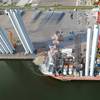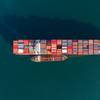Registration is now open for the American Salvage Association (ASA) and the North American Marine Environmental Protection Association (NAMEPA) co-sponsored conference, “Wrecks of the World II (WOW II): Evaluating and Addressing Potential Underwater Threats” to be held on Monday, June 6 and Tuesday, June 7 at the Maritime Institute of Technology and Graduate Studies (MITAGS) in the Washington, DC area (Linthicum Heights, MD) USA. The conferencewill explore the myriad issues (pollution threat, regulatory, risk assessment, oil removal and remediation, implications to the environment, legal, insurance and funding issues, next steps) related to the more than 8,500 sunken vessels in the world, many of them World War II-era.
The problem of potentially-polluting wrecks has long been discussed and recent incidents around the world have caused government agencies and responsible parties to look proactively at preventing catastrophic oil and other chemical releases from long submerged shipwrecks. These wrecks may contain as much as 20 million tons of oil and other hazardous materials. Sporadic or continuous leakages or potential sudden massive spillages from these wrecks pose a continual risk across the globe.
With the work that has recently occurred in the U.S. including remediation of the Beaumont off the Texas coast and the Princess Kathleen on the Alaskan coast, anticipated work on the Montebello off of California and on the Coimbra off of New York among others, as well as oil recovery from the wrecks of the Asian Forest and the Black Rose off the coast of India, not to mention the oil removal projects being considered by the Canadian, Korean and Norwegian governments, among others, wreck oil removal has come to the forefront of marine environmental concerns. The risk of oil and other hazardous materials seeping out of sunken shipwrecks is growing yearly, and the likelihood of leakage or even a massive spill occurring increases, as do the potential costs. Taking a proactive rather than a reactive approach to mitigating this risk will save not only dollars in response costs, but also reduce the threat of environmental and socioeconomic damages.
From the viewpoint of environmental and economic impacts, there is little difference between oil spilling from a long sunken vessel and oil spilling from a modern day vessel casualty, with the exception that, while there is no way to predict the location or timing of the next major oil spill, potentially-polluting wreck sites are known and the probability of a spill event is quantifiable or even inevitable. There is ample evidence that there are a large number of wrecks in U.S. coastal waters and elsewhere around the world that are spills waiting to happen.
“This WOW II conference is one not to be missed this year because it is the only one of its kind that focuses on spills emanating from sunken shipwrecks. The United States – and the world – are increasingly concerned about the risks to the marine environment as that risk increases with each day,” said Mauricio Garrido, President of the ASA.
“Particularly since last year’s Deepwater Horizon oil release, there is no tolerance for oil or any hazardous materials being released into the environment,” said Clay Maitland, Founding Chairman of NAMEPA. “The amount of scrutiny is evidenced by a recent 5 gallon oil sheen detected in the Gulf and became a national news item. Now is the opportunity to be proactive about potential threats, which will realize cost and environmental benefits in the long run.”
The conference program is nearly finalized and is available, along with on-line registration capability, on the ASA and NAMEPA:












